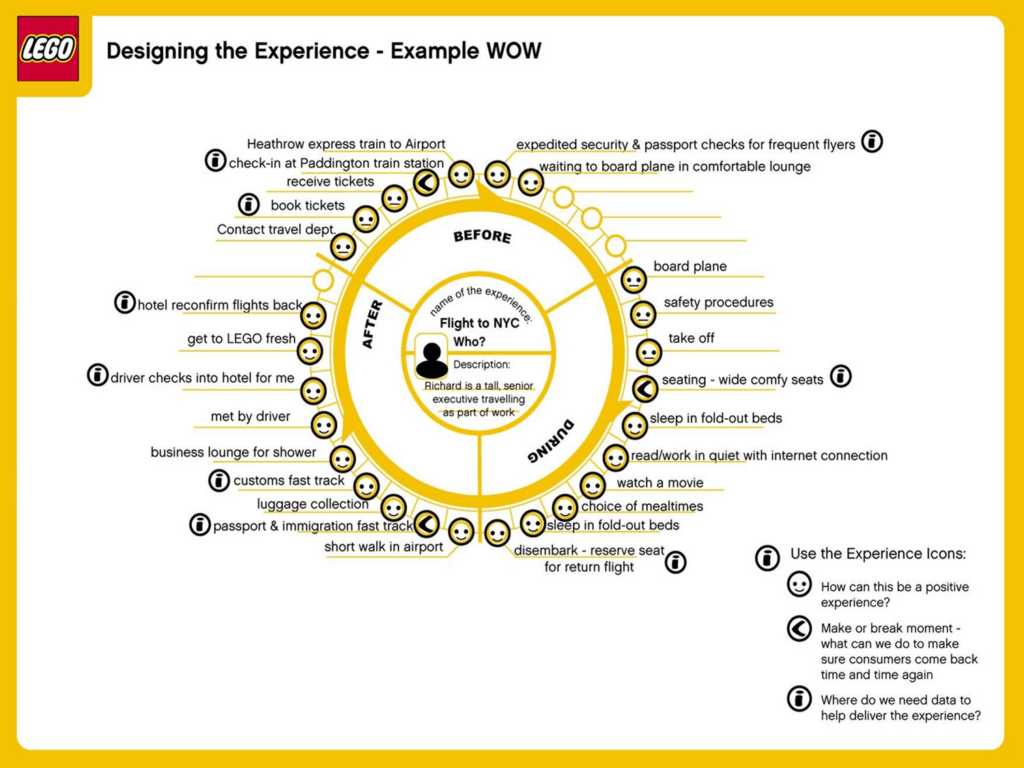Understanding what your customers are doing is such a sexy, intriguing topic.
We all want to better comprehend why our customers behave the way they do and when they make certain choices. If we can understand that, then we can understand what and how and when to sell, communicate and appreciate them!
That’s why customer journey mapping is such an inviting idea. When we map out the actual journey our customers take and turn it into a beautiful visual? Well, that’s like crack to marketers and executives alike.
But therein lies the problem.
Beautiful customer journey maps are easy to find. Lego’s “Experience Wheel” model is a popular example you may have seen before, and for good reason, because it’s gorgeous and compelling.

And while Lego’s Journey Map is wonderful, it’s a mistake to think that a Journey Map is useful solely because it looks good.
I love a good Journey Map — Heck, I’ve got a Linkedin Learning course all about it — but it’s a mistake to think that a beautiful Journey Map necessarily makes a useful one.
For every Journey Map like Lego’s — beautiful and useful — there are dozens of Journey Maps out there whose lack of usefulness is obscured by how darn pretty it looks.
Here are five common mistakes that can limit your Journey Map’s ability to deliver the outcomes you want.
I’ve worked on my fair share of journey mapping projects. Too often, it is driven by a leader stating “we need a map!”
This means everyone working on the project thinks the end-goal is a suitable visual deliverable.
When “create a map” is the goal, the conversation tends to be driven by aesthetics:
“Let’s make it a subway map!”
“No, let’s make it a circle.”
We get so caught up in the deliverable, we forget that the real driver should be to improve the customer experience.
We did it! After months of mapping a customer’s true experience, the team high fives each other and moves on to other important initiatives. This means the project was a success, right?
Wrong.
Journey mapping is about the process, and it’s about the process over and over and over again!
Completing your Journey Map is an initial step — not the end goal. Once it’s created, it’s time to find ways to incorporate it into your internal processes, to assess its effectiveness, and to continue revising it over time as more information becomes available.
Did you know $6 billion is spent on Customer Relationship Management software that’s never used?
Software can seem like the solution, so organizations want to believe! They sign a contract and cross their fingers.
But when we use a software-first approach without a strong process in place, the software tends to shape the process. The result is we end up augmenting our systems to fit the needs of the software, not the customer.
Software can absolutely be part of the solution, but it’s not a starting point.
I attended a workshop from a large organization well known for journey mapping. They made a point of stressing what needs to be left off the map. Sometimes the critical pieces are ignored because it’s only a small group of customers affected.
I bristle at this!
Journey mapping could help you find small problems that will be BIG issues in the future, but only if you actually include it all.
Your journey mapping exercise should lead to real action to improve your customer experience. It’s difficult to change a beautiful, overly-designed image.
Sometimes the best journey maps aren’t that pretty, but inform everyone of what needs to be done.
After several years of seeing these types of mistakes, we developed a way to track individual touchpoints that doesn’t require software or designers. It’s not always pretty, but it works.
How many of these Journey Map mistakes has your organization made? And more importantly, what have you learned from them? What customer journey mapping successes has it led to?
 Jeannie is an award-winning customer experience expert, international keynote speaker, and sought-after business coach who is trailblazing the movement from “Reactive Customer Service” to “Proactive Customer and Employee Experience.” More than 500,000 people have learned from her CX courses on LinkedIn Learning, and her insights have been featured in Forbes, The Chicago Tribune, The Wall Street Journal and NPR.
Get Jeannie’s insights in your inbox each week by subscribing to The Weekly Win and follow her on LinkedIn, Instagram and YouTube.
Jeannie is an award-winning customer experience expert, international keynote speaker, and sought-after business coach who is trailblazing the movement from “Reactive Customer Service” to “Proactive Customer and Employee Experience.” More than 500,000 people have learned from her CX courses on LinkedIn Learning, and her insights have been featured in Forbes, The Chicago Tribune, The Wall Street Journal and NPR.
Get Jeannie’s insights in your inbox each week by subscribing to The Weekly Win and follow her on LinkedIn, Instagram and YouTube.